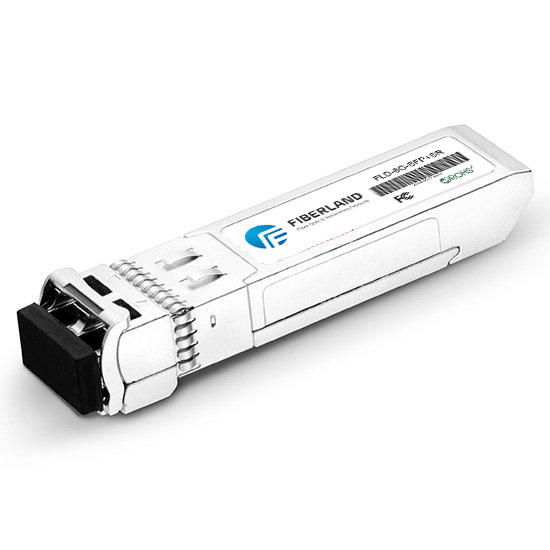What are the DDM, DOM, and RGD function of the optical module?
2017-10-13
If you are the first time to buy optical transceivers, you might be confused with "DDM", "DOM" or "RGD". What are they? Today, Fiberland will describe in detail the functions of these three types of optical modules.

What is DDM?
DDM means Digital Diagnostic Monitoring. It is the technique used in the optical module so that users can monitor the real-time parameters of the module. Including modules’ working temperature, working voltage, working current, TX and RX Power etc, can also show the factory information of the optical transceiver, prompt warning/alarm.
The DDM function of the module can provide a performance monitoring tool for the system, can help the system manage and predict the life of the module, isolate the fault system and verify the compatibility of the module in installation.
What is DOM?
DOM means Digital Optical Monitoring. Its function is similar to DDM, allows you to monitor all aspects data of optical module in real time. Such as modules’ transmit and receive, input and output power, temperature and voltage. The network administrator checks these data to make sure that the optical module is working properly.
Obviously, optical modules with DDM/DOM function are better than optical modules without these functions, therefore, most optical modules conform to the SFF-8472 standard and can support DDM/DOM function.
What is RGD?
RGD means rugged optical modules, so the optical module with RGD function is an enhanced module. This optical module is more durable and can be used in very harsh conditions. The rugged optical module has enhanced ESD protection and a greater range of operating temperatures. Thus, field failures can be eliminated, not need expensive external protection devices.
Recommended optical module with DDM
The optical modules listed above are available by Fiberland. In addition, we also supply other modules compatible with HUAWEI, H3C and other major brands, varieties of models and styles for you to choose. More SFP optical modules tutorials and solutions, welcome to visit our website: http://www.fiberlandtec.com/

What is DDM?
DDM means Digital Diagnostic Monitoring. It is the technique used in the optical module so that users can monitor the real-time parameters of the module. Including modules’ working temperature, working voltage, working current, TX and RX Power etc, can also show the factory information of the optical transceiver, prompt warning/alarm.
The DDM function of the module can provide a performance monitoring tool for the system, can help the system manage and predict the life of the module, isolate the fault system and verify the compatibility of the module in installation.
What is DOM?
DOM means Digital Optical Monitoring. Its function is similar to DDM, allows you to monitor all aspects data of optical module in real time. Such as modules’ transmit and receive, input and output power, temperature and voltage. The network administrator checks these data to make sure that the optical module is working properly.
Obviously, optical modules with DDM/DOM function are better than optical modules without these functions, therefore, most optical modules conform to the SFF-8472 standard and can support DDM/DOM function.
What is RGD?
RGD means rugged optical modules, so the optical module with RGD function is an enhanced module. This optical module is more durable and can be used in very harsh conditions. The rugged optical module has enhanced ESD protection and a greater range of operating temperatures. Thus, field failures can be eliminated, not need expensive external protection devices.
Recommended optical module with DDM
The optical modules listed above are available by Fiberland. In addition, we also supply other modules compatible with HUAWEI, H3C and other major brands, varieties of models and styles for you to choose. More SFP optical modules tutorials and solutions, welcome to visit our website: http://www.fiberlandtec.com/
RECENT BLOG POST
-
012019-10With the continuous development of 5G communication technology, 100G modules are gradually becoming popular. We know that there are many kinds of packages for 100G optical modules. From 2000 to now, the optical module package types have been rapidly developed. Its main package types are: GBIC, SFP, XENPAK, SNAP12, X2, XFP, SFP+, QSFP/QSFP+, CFP, CXP. In the fast-developing network era, some 100G optical modules avoid the risk of being eliminated, and upgraded and revised with the wave of the Internet, such as 100G CFP optical modules.
-
012019-101. What is the CWDM SFP? The CWDM optical module is an optical module using CWDM technology to implement the connection between the existing network device and the CWDM multiplexer/demultiplexer. When used with a CWDM multiplexer/demultiplexer, CWDM optical modules can increase network capacity by transmitting multiple data channels with separate optical wavelengths (1270 nm to 1610 nm) on the same single fiber.
-
012019-10AOC is the abbreviation of Active Optical Cables, which is called Active Optical Cables in Chinese. AOC active optical is to encapsulate two optical modules and cable together. Because the medium of transmission in the middle is optical cable, AOC optical module, which contains laser devices, has a higher price for DAC. However, its optical aperture is not exposed, it has high reliability, and its working distance can be customized for a long distance of less than 100 meters.
-
012019-10Dense Wavelength Division Multiplexing (DWDM) technology is capable of transmitting data in an optical fiber using bit wavelength parallel transmission or string line transmission using the wavelength of the laser.It is widely used in different fields of communication networks, including long-distance backbone networks, metropolitan area networks (MANs), residential access networks, and local area networks (LANs).The DWDM optical module is the optical module that uses this technology, so the DWDM optical module has high bandwidth and long-distance transmission characteristics.












